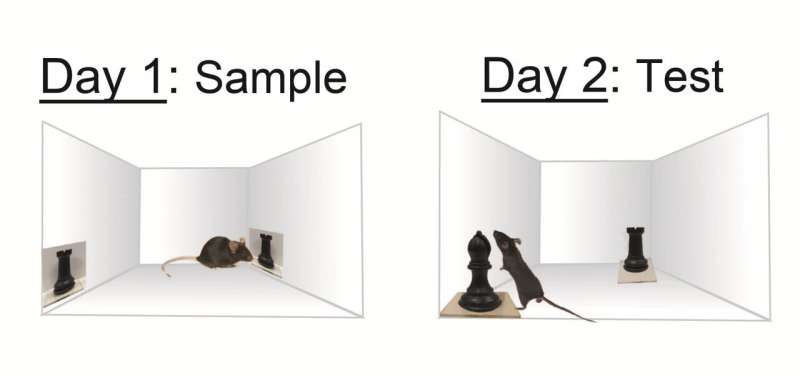Photo or the real thing? Mice can inherently recall and tell them apart

A picture is worth a thousand words, especially when it triggers memories of the pictured object like a vacation photo. 2D visual stimuli, such as pictures seen in print media, television or online, is often how humans acquire knowledge about real-world items. In such formats, the 2D stimuli act as symbols of the actual physical item.
The ability to perceive that a 2D picture of an object corresponds to its 3D physical form or "picture-to-object equivalence" is a cognitive function thought to be exclusive to higher-order species such as primates and some birds. It has been suggested that this "representational insight" may be beyond the ability of rodents or poses substantial problems in experimental design.
A study by researchers at Florida Atlantic University challenges this theory and provides the very first behavioral evidence that laboratory mice are capable of high-level picture-to-object perceptual abilities. They have confirmed that mice perceive the inherent difference between a picture of an object and the actual 3D object itself.
Using a modified object recognition task, researchers allowed naïve mice to view photographs (2D stimuli) of an object during a sample session. The next day, the mice were presented with a novel 3D object and the actual 3D object viewed the day before in 2D photograph.
Interestingly, the results of the study, published in Scientific Reports, showed that the mice overwhelmingly preferred to explore the novel 3D object over the "familiar" 3D object. This first-of-its-kind evidence reveals that mice can successfully perform a cognitive task of picture-to-object equivalence reminiscent of those used to test visual recognition memory in children and non-human primates. Importantly, these findings suggest that after encoding the 2D visual stimuli, mice employed higher-order cognitive processes to associate the 3D item with the recalled memory of the 2D referent.
Findings also indicate that the mouse hippocampus (a primary structure of the brain's medial temporal lobe memory system), like that of humans, contributes significantly to the representational or transitive inference necessary for picture-to-object equivalence. Further, they found that picture memory, required for such higher-order inference, depends upon neuronal activity in the CA1 region dorsal hippocampus.
"Our study challenges the view that perceptual limitations of mice render them inappropriate for modeling human memory and visual processing and that familiarity-based recognition is independent of the hippocampus," said Robert W. Stackman Jr., Ph.D., senior author, dean, FAU Graduate College, professor of neuroscience, Department of Psychology, FAU Charles E. Schmidt College of Science, and a member of the FAU Jupiter Life Science Initiative, FAU Stiles-Nicholson Brain Institute, FAU Center for Complex Systems and Brain Sciences and FAU Institute for Human Health and Disease Intervention (I-Health). "Our findings also provide strong support that a functional mouse hippocampus is required for this form of nonspatial visual recognition memory and picture-object equivalence."
If mice spent sufficient time (greater than 30 seconds) viewing pictures of an object, they then could subsequently discriminate between a "familiar" 3D physical object and a novel 3D physical object, even when low-level visual strategies were controlled. This picture-object equivalence capability occurred regardless of object symmetry, likeness, viewing angle, composition, and image realism. Even when low-level visual features, such as color and luminance are controlled for, mice are still able to generalize from 2D picture to 3D object.
"In primates, the hippocampus is thought to play an essential role in declarative or explicit memory enabling an individual to replay a 'story' of a previously encoded experience," said Sarah J. Cohen, Ph.D., first author and a post-doctoral fellow, FAU Center for Complex Systems and Brain Sciences and FAU Jupiter Life Science Initiative. "We suggest that that 'story' enables one to recognize items learned in picture form when they are subsequently presented in 3D form. The mouse hippocampus likely encodes and consolidates the picture exploration as a 'story' of that experience or event, within a specific context as a form of explicit memory."
Recognition memory is well established in mice, yet results from this study extend that research to indicate that rodents are capable of advanced visual recognition and learn indirectly about actual objects by viewing images. The role of the hippocampus may be to retrieve the memory of the picture explored during the sample session, against which the mouse can appropriately match to one of the items available during the test session.
"Mice can make perceptual and conceptual judgments about presented task stimuli, which is surprising given that picture-object equivalence has been considered a defining capacity of primates," said Stackman. "Taken together, our results provide convincing evidence that the mouse may serve as an effective model organism to investigate higher-order sophisticated aspects of mammalian visual perception and recognition."
More information: Sarah J. Cohen et al, Mice recognize 3D objects from recalled 2D pictures, support for picture-object equivalence, Scientific Reports (2022). DOI: 10.1038/s41598-022-07782-4



















